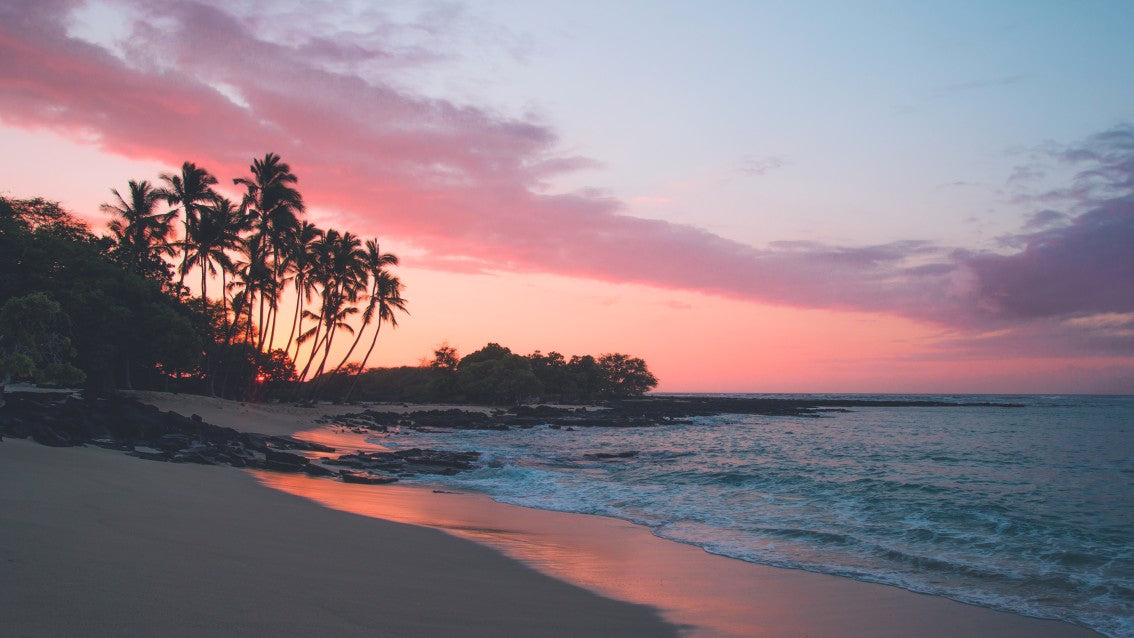
Hawaii History: Everything You Need to Know
Hawaii is a place synonymous with sunshine, relaxation, and beaches for miles. For those of us who have been lucky enough to travel to Hawaii, we understand the hype. The breathtaking beauty of the eight islands that make up Hawaii is unmatched. It keeps Hawaii as one of the top travel destinations for individuals from every country across the globe.
There is so much more to Hawaii than just what meets the eye. Hawaiian history is rich. It spans hundreds of thousands of years, with the first settlement noted in 300 C.E. We at Whaler's Locker are passionate about all things Hawaii and would love to give you a deep-dive into the history of this amazing state!

Read on for Hawaii's history and our recommendations for Hawaii swag to show your love for these exotic islands. We are confident you'll come away loving Hawaii just as much as we do!
Hawaii's History Basics
Before we dive in-depth into Hawaii's history, we want to provide a quick overview of one of the most beautiful places on Earth. As the only state in the United States comprised entirely of islands, it is set apart from its landlocked counterparts. There are 137 islands total that make up the archipelago of Hawaii, with the eight largest islands serving as the state's main islands. These eight islands are Ni'ihau, Kaua'i, O'ahu, Moloka'i, Lana'i, Kaho'olawe, Maui, and the Big Island of Hawaii.
Hawaii has over 1.4 million permanent residents and plays host to thousands of tourists and military personnel, as well. The capital of Hawaii is Honolulu, found on the island of O'ahu. Centrally located in the Pacific, Hawaii saw an influx of laborers migrate to the main islands during the 19th century. As such, the culture of Hawaii has strong influences from North American and East Asian culture. Indigenous Hawaiian culture also presents a strong influence, as well.
Early Hawaii: 300 C.E.

The earliest record of settlement in Hawaiian history came from 300 C.E., when Polynesians paddled their canoes over 2,000 miles from the Marquesas Islands to the Big Island. Following this first migration, the second wave of migration occurred, made up of settlers from Bora Bora to Maui and the other main islands within the archipelago.
These original Hawaiian islanders were extremely skilled fishermen and farmers, and quickly established small communities ruled by chieftains. These chieftains, known as ali'i, ruled over their settlements but often engaged in warfare with other chieftains to extend their influence and take over neighboring communities.
European Arrival: 1778
Europeans reached the shores of Kauai in 1778 when Captain James Cook first set foot on the Big Island. Cook claimed it in the name of John Montague, the Earl of Sandwich, referring to the archipelago as "the Sandwich Islands."
Upon his return, one year later, he was killed by Hawaiians during a scuffle at Kealakekua Bay, located on the Big Island. After taking Hawaiian temple idols and fencing to be used for firewood, a minor chief and his men stole a boat from Cook's ship. In response, Cook kidnapped Kalani'opu'u, the King of the Big Island, and held him for ransom until the Hawaiians returned his boat. Kalani'opu'u's supporters attacked and killed Cook and four of his sailors as they attempted to retreat.

Cook's visit led to the publication of several books about Hawaii, which prompted further European visitation. Explorers, traders, and whalers frequently stopped on the Hawaiian Islands during their travels, as they found the Hawaiian harbors inviting and full of much-needed supplies for their voyages. Noted in Hawaiian history is the initial arrival of both British and Chinese explorers and travelers, as well.
After taking down the European intruders, the Hawaiians living on the Big Island, Maui, and the other main islands within the archipelago united into one territory under the rule of King Kamehameha. He ruled from 1810 to 1819. He is still celebrated yearly with floral parades on King Kamehameha Day, a beautiful display of respect for Hawaii's history.
The House of Kamehameha
The House of Kamehameha ruled over Maui and the other Hawaiian Islands until 1872. During the reign of this great house, five different kings ruled and dealt with various changes and challenges to their power, including the arrival of Christian missionaries in 1819. These missionaries exerted incredible influence over the Hawaiian people and, as a result, ended many traditional practices based on Hawaiian culture.

During King Kamehameha III's reign, he signed the Constitution of 1840, and Hawaii converted to a Christian monarchy. Hiram Bingham I, a Protestant missionary who became King Kamehameha's trusted friend and advisor, spearheaded Hawaii's transition to a Christian monarchy. After the death of King Kamehameha V, who did not name an heir before his end, there was unrest regarding the leadership of the Hawaiian archipelago.
By 1887, the Hawaiian Legislative Assembly has elected King Kalakaua to rule. However, he was quickly forced to sign the 1887 Constitution of the Kingdom of Hawaii. Drafted by white businessmen and lawyers, this constitution drastically reduced the authority of the monarch. The documents disenfranchised many Hawaiians and favored the wealthy white elite in terms of voting rights. King Kalakaua reigned as a figurehead until 1891.
The Republic of Hawaii: 1894
By January of 1893, John L. Stevens, United States Minister to the Kingdom of Hawaii, conspired with U.S. citizens to overthrow the monarchy of Hawaii once and for all. Following the overthrow, a Hawaiian citizen named Sanford B. Doyle became President of the Republic. As the years passed and Queen Lili'uokalani attempted to regain her throne, the United States stepped in. Though the administration of Grover Cleveland concluded that the overthrow of the Hawaiian Queen had been illegal, the Republic of Hawaii refused to reinstate the monarch to a position of power.
Hawaii's Annexation: 1898
When William McKinley was elected President of the United States in 1896, annexationists and expansionists persuaded him to annex Hawaii to the United States. Hawaii's history notes that, despite the pushback from the residents of Hawaii, the House of Representatives and the Senate passed a resolution in 1898 to annex Hawaii to the United States.

In 1900, Maui and the other Hawaiian Islands were granted self-governance and re-established the seat of political power at Iolani Palace in Honolulu. Because plantation owners and capitalists maintained control of Hawaii, Hawaii remained a territory for 60 years. Its territory status allowed said plantation owners and capitalists to continue to import cheap, foreign labor, prohibited in many states in the United States. Plantation owners were eager to keep Hawaii a territory to continue the practice unimpeded.
From 1899 to 1965, waves of immigration from Puerto Rico and Korea began. Puerto Ricans traveled to Hawaii after a hurricane severely disrupted the sugar industry. Maui and the other Hawaiian Islands' sugar became widely coveted across the globe, and plantation owners recruited Puerto Rican laborers for their skill in harvesting sugarcane. Korean immigration took off after President Lyndon B. Johnson signed the Immigration and Nationality Act of 1965, removing racial and national barriers to emigration.
Present-Day Hawaii
Following the rise in power of the Democratic Party of Hawaii in 1950, residents of Maui and the other Hawaiian Islands advocated for statehood, eager for more representation in the United States' government. In 1959, President Dwight D. Eisenhower passed a referendum to bring statehood to Hawaii. After reaching statehood, Hawaii began modernization through construction and an increase in the tourist economy.

In 2019, Hawaii's culture draws heavily from its Polynesian ancestors. Traditional Polynesian ceremonies are practiced, to the delight of residents and tourists alike. The cuisine of Hawaii is a blend of Polynesian and native Hawaiian dishes, along with influences from Korea, Puerto Rico, and the United States. State parks reign supreme for their beauty and elegance. The music played and sports practiced in Hawaii draw from deep Polynesian and Native Hawaiian traditions.
Tourism remains a significant part of the Hawaiian economy, with over 6.4 million tourists visiting Maui and the other Hawaiian Islands yearly. Many tourists visit for cultural events, such as the Merrie Monarch Festival, an international Hula competition. The Hawaiian Islands are a popular destination for weddings and honeymoons, as well.
Scrimshaw in Hawaiian History
As far back as the 1800s, scrimshaw has been a consistent feature in not only Hawaiian history but in the accounts of many other island countries. Scrimshaw is the process of creating scrollwork, engravings, or carvings in bone or ivory. This bone and ivory typically come from the byproducts of whales, which include teeth, bones, and cartilage. Nantucket native Edward Burdett created the first examples of scrimshaw.
The creation of scrimshaw stemmed from whalers' long and arduous expeditions, with hours spent watching the calm oceans for a sign of a whale. Whalers would carve scrimshaw into the byproducts of previously captured whales to mitigate their boredom, honing their craft and creating delicate, intricate engravings for loved ones back onshore.
Scrimshaw's primary purpose in present-day Hawaii is gift-giving. The variety of designs featured in these carvings and engravings are sure to delight friends and family members alike. Those who engraved scrimshaw will take requests for the design of the carving, so scrimshaw can be personalized to fit the interest of whoever receives it as a gift!
We've come up with a list of our favorite scrimshaw pieces for you to check out:- Handmade Scrimshaw Magnifying Glass: This gorgeous handmade magnifying glass features polished wood with bone inlay and a design created by a local Maui Perfect for your father's desk!
- Scrimshaw Deer Antler Maui Fish Hook: This item is another beautifully unique, handcrafted piece to reflect your loved one's interest in Hawaii's history and culture. This necklace is a conversation-starter!
- Scrimshaw Lockback 3.5" Pocket Knife: With nickel and silver accenting the smooth bone of the handle, this pocket knife is not only functional but also beautiful. An intricately carved whale's tail stands out on one side and you'll find the word 'Maui' engraved on the other.
Other Unique Hawaiian Gifts
Along with scrimshaw, Whaler's Locker offers a variety of traditional Hawaiian gifts for your friends and loved ones to enjoy! These gifts will have them dreaming of Maui in no time.
Our XX Large Butterfly Wing Pendant features real butterfly wings set in a pendant made of high-quality acrylic and silver. Each piece is unique and offered in a variety of colors to suit anyone's style! Grab the beautiful black and blue pendant for your mother or the pearl pendant for your sister and watch their eyes light up immediately.
What could be cooler than receiving an authentic Megalodon tooth as a gift? Available in a variety of sizes, these teeth are entirely intact, allowing you to get a glimpse at the original tooth and enamel. You won't find a better gift to celebrate Hawaii's history than one of these Megalodon teeth!
Finally, a Maui Fish Hook necklace that has been hand-carved by a local Maui artist adds the perfect touch of Hawaiian flair to your loved one's style. This necklace is ideal for anyone in your life who is interested in Hawaiian culture or has dreams of living the surfer lifestyle on the shores of Maui.
For the Love of Hawaii
Since 1971, Whaler's Locker has been spreading the joy of Hawaii and Hawaiian culture across the globe. Our dedication to providing unique, handcrafted products steeped in Hawaii's history is unmatched, and we are proud to have called Maui our home base for many years.
We happily ship our products to all 50 states and are eager to help you find the perfect Hawaiian gift for yourself or one of your loved ones. Take a look through the wide variety of gift collections we offer. No matter whom you're shopping for, you're sure to find the perfect piece!



